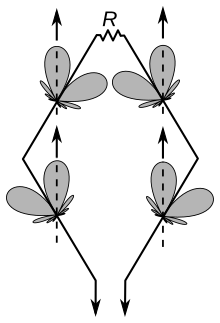Rhombus antenna
A rhombus antenna is a diamond-shaped directional antenna . It was invented by Edmond Bruce and Harald Friis in the 1940s .
This type of antenna requires a lot of installation space, but due to its simple design it offers a high degree of efficiency, since the transmission energy is radiated in a flat and narrow lobe. The rhombus antennas are mainly used in the shortwave frequency range .
construction
Rhombus antennas differ in two variants. The version that is open at the end, which radiates bidirectionally, and the more frequently used closed version, which radiates unidirectionally and requires a terminating resistor at the end.
The antenna essentially consists of two symmetrically fed, horizontally running wires that are spread apart and brought together again. The leg length should be about three times the longest wavelength . The construction height is about half a wavelength above the ground. Instead of a terminating resistor, however, a so-called absorption line made of resistance wire with at least 6 times the wavelength can be used, to the end of which a absorption resistor is connected.
The transmitter feed is usually carried out with an open ribbon cable , which is the cheapest solution for rhombus antennas because it can be built with an impedance of 600 ohms, which corresponds approximately to that of the antenna.
Web links
Individual evidence
- ↑ US Patent 2,285,565 ( Memento from January 27, 2012 in the Internet Archive ) (PDF; 373 kB)
- ^ Radio Antenna Engineering, EA, Laport, McGraw-Hill, 1952, pages 315-334


